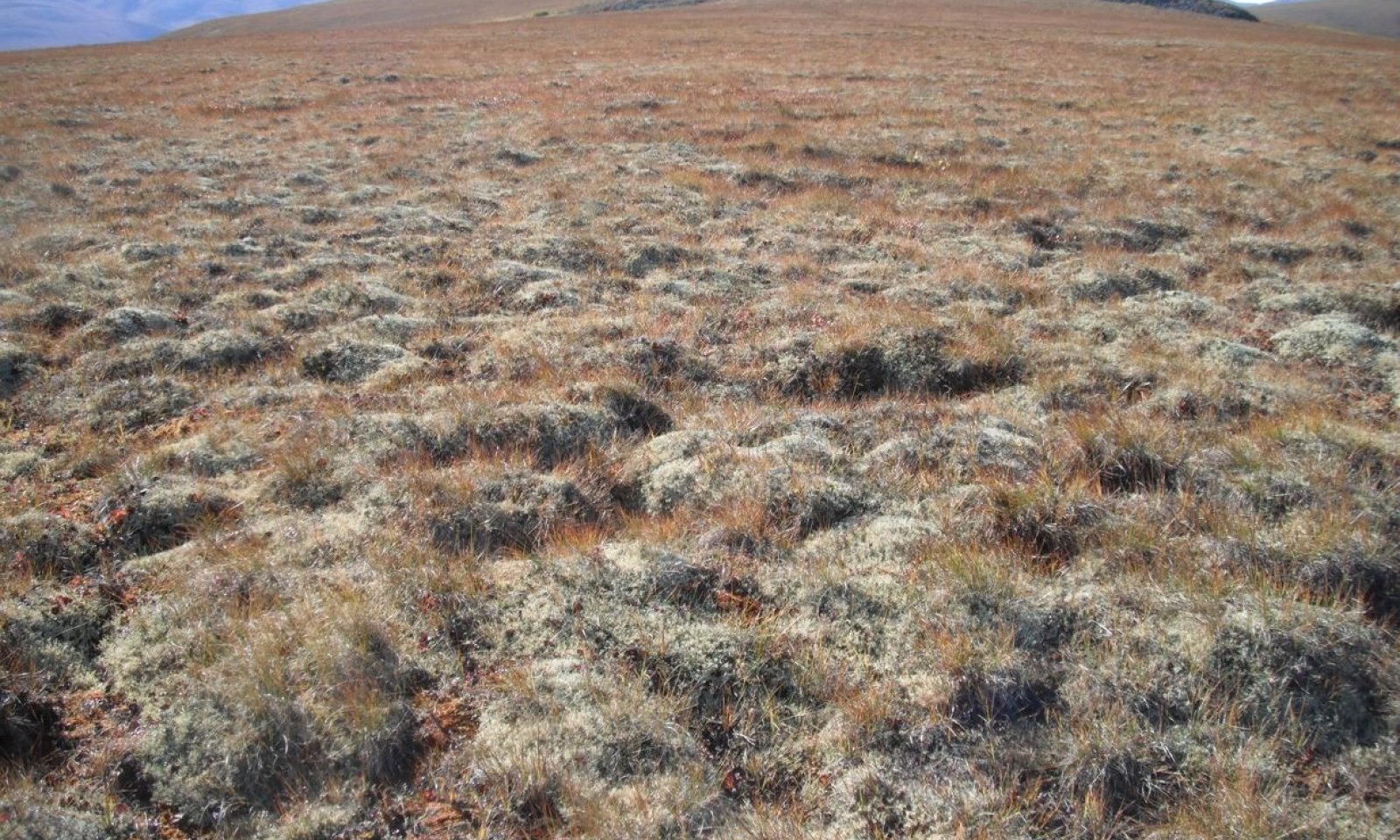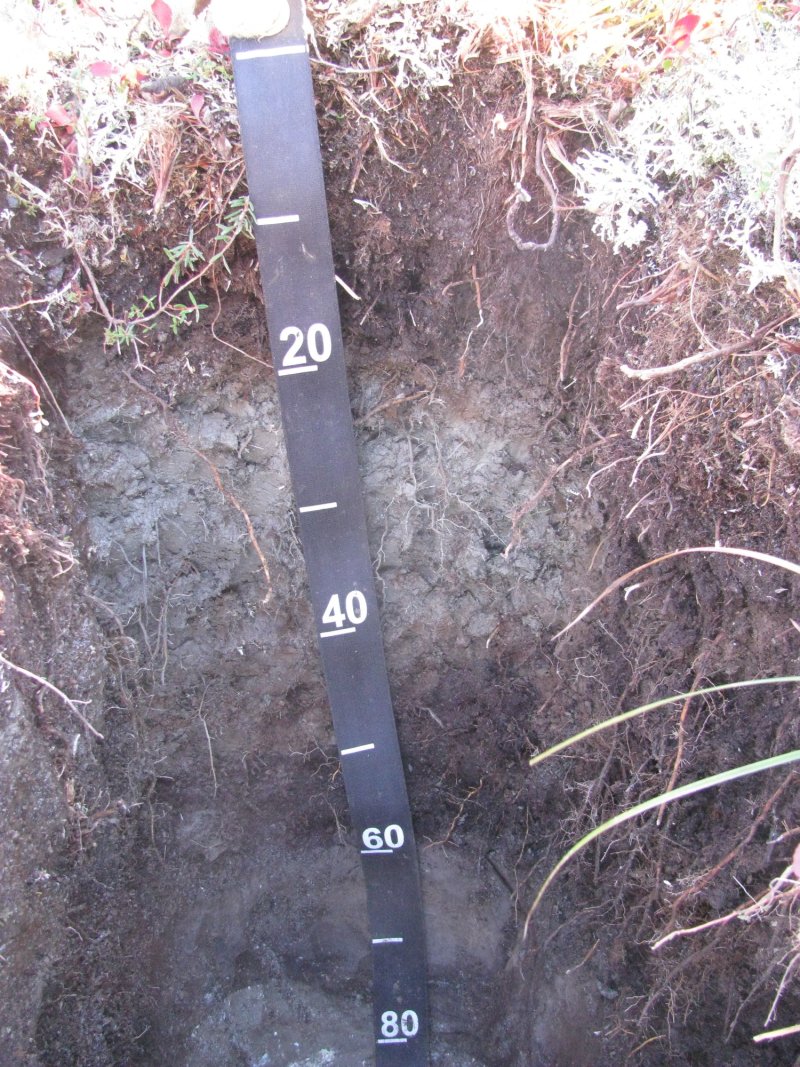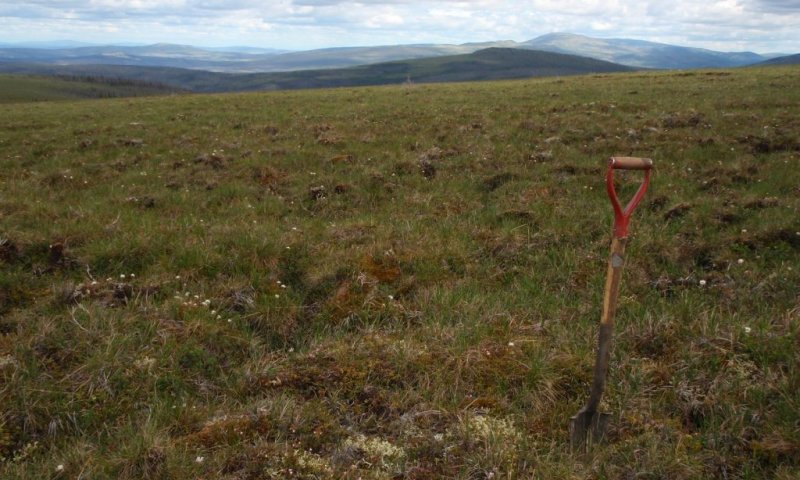

Natural Resources
Conservation Service
Ecological site R231XY115AK
Alpine sedge silty frozen slopes
Last updated: 2/13/2024
Accessed: 04/28/2025
General information
Provisional. A provisional ecological site description has undergone quality control and quality assurance review. It contains a working state and transition model and enough information to identify the ecological site.
MLRA notes
Major Land Resource Area (MLRA): 231X–Interior Alaska Highlands
The Interior Alaska Uplands (MLRA 231X) is in the Interior Region of Alaska and includes the extensive hills, mountains, and valleys between the Tanana River to the south and the Brooks Range to the north. These hills and mountains surround the Yukon Flats Lowlands (MLRA 232X). MLRA 231X makes up about 69,175 square miles. The hills and mountains of the area tend to be moderately steep to steep resulting in high-relief slopes. The mountains are generally rounded at lower elevations and sharp-ridged at higher elevations. Elevation ranges from about 400 feet in the west, along the boundary with the Interior Alaska Lowlands (MLRA 229X), to 6,583 feet at the summit of Mt. Harper, in the southeast. Major tributaries include large sections of the Yukon, Koyukuk, Kanuti, Charley, Coleen, and Chatanika Rivers. This area is traversed by several major roads, including the Taylor Highway in the east and the Steese, Elliott, and Dalton Highways north of Fairbanks. The area is mostly undeveloped wild land that is sparsely populated. The largest community along the road system is Fairbanks with smaller communities like Alatna, Allakaket, Chicken, Eagle, Eagle Village, Hughes, and Rampart occurring along the previously mentioned rivers and highways.
The vast majority of this MLRA was unglaciated during the Pleistocene epoch with the exceptions being the highest mountains and where glaciers extended into the area from the Brooks Range. For the most part, glacial moraines and drift are limited to the upper elevations of the highest mountains. Most of the landscape is mantled with bedrock colluvium originating from the underlying bedrock. Valley bottoms are filled with Holocene fluvial deposits and colluvium from the adjacent mountain slopes. Silty loess, which originated from unvegetated flood plains in and adjacent to this area, covers much of the surface. On hill and mountain slopes proximal to major river valleys (e.g., Tanana and Yukon Rivers), the loess is many feet thick. As elevation and distance from major river valleys increases, loess thickness decreases significantly. Bedrock is commonly exposed on the highest ridges.
This area is in the zone of discontinuous permafrost. Permafrost commonly is close to the surface in areas of the finer textured sediments throughout the MLRA. Isolated masses of ground ice occur in thick deposits of loess on terraces and the lower side slopes of hills. Solifluction lobes, frost boils, and circles and stripes are periglacial features common on mountain slopes in this area. Pingos, thermokarst pits and mounds, ice-wedge polygons, and earth hummocks are periglacial features common on terraces, lower slopes of hills and mountains, and in upland valleys in the area.
The dominant soil orders in this area are Gelisols, Inceptisols, Spodosols, and Entisols. The soils in the area have a subgelic or cryic soil temperature regime, an aquic or udic soil moisture regime, and mixed mineralogy. Gelisols are common on north facing slopes, south facing footslopes, valley bottoms, and stream terraces. Gelisols are typically shallow or moderately deep to permafrost (10 to 40 inches) and are poorly or very poorly drained. Wildfires can disturb the insulating organic material at the surface, lowering the permafrost layer, eliminating perched water tables from Gelisols, and thus changing the soil classification. Inceptisols and Spodosols commonly form on south facing hill and mountain slopes. Entisols are common on flood plains and high elevation mountain slopes. Miscellaneous (non-soil) areas make up about 2 percent of this MLRA. The most common miscellaneous areas are rock outcrop and rubble land. In many valleys placer mine tailings are common.
Short, warm summers and long, cold winters characterize the subarctic continental climate of the area. The mean annual temperature of the area ranges from 22 to 27 degrees F. The mean annual temperature of the southern half of the area is approximately 3 degrees warmer compared to the northern half (PRISM 2018). The warmest months span June through August with mean monthly temperatures ranging from 50 to 56 degrees F. The coldest months span November through February with mean monthly temperatures ranging from -5 to 3 degrees F. When compared to the high-elevation alpine and subalpine life zones, the lower elevation boreal life zone tends to be 2-3 degrees F colder during the coldest months and 1-2 degrees F warmer during the warmest months (PRISM 2018). The freeze-free period at the lower elevations averages about 60 to 100 days, and the temperature usually remains above freezing from June through mid-September.
Precipitation is limited across this area, with the average annual precipitation ranging from 12 to 19 inches. The southern half of the areas receives approximately 2.5 inches more annual precipitation then the northern half (PRISM 2018). The lower elevation boreal life zone receives approximately 2.5 inches less annual precipitation than the high-elevation alpine and subalpine life zones (PRISM 2018). Approximately 3/5th of the annual precipitation occurs during the months of June through September with thunderstorms being common. The average annual snowfall ranges from about 45 to 100 inches. The ground is consistently covered with snow from November through March.
Most of this area is forested below an elevation of about 2500 feet. Dominant tree species on slopes are white spruce and black spruce. Black spruce stands are most common on north-facing slopes, stream terraces, and other sites with poor drainage and permafrost. White spruce stands are most common on warm slopes with dry soils. At lower elevations, lightning-caused wildfires are common, often burning many thousands of acres during a single fire. Following wildfires, forbs, grasses, willow, ericaceous shrubs, paper birch, and quacking aspen communities are common until they are eventually replaced by stands of spruce. Tall willow and alder scrub is extensive on low flood plains. White spruce and balsam poplar are common on high flood plains.
With increasing elevation, the forests and woodlands give way to subalpine communities dominated by krummholz spruce, shrub birch, willow, and ericaceous shrubs. At even higher elevations, alpine communities prevail which are characterized by diverse forbs, dwarf ericaceous shrubs, and eightpetal mountain-avens. Many of these high elevation communities have a considerable amount of lichen cover and bare ground.
LRU notes
This area supports three life zones defined by the physiological limits of plant communities along an elevational gradient: boreal, subalpine, and alpine. The boreal life zone is the elevational band where forest communities dominate. Not all areas in the boreal life zone are forest communities, however, particularly in places with too wet or dry soil to support tree growth (e.g., bogs or river bluffs). Above the boreal band of elevation, subalpine and alpine vegetation dominate. The subalpine zone is typically a narrow transitional band between the boreal and the alpine life zones, and is characterized by sparse, stunted trees. In the subalpine, certain types of birch and willow shrub species grow at ≥ 1 m in height (commonly Betula glandulosa and Salix pulchra). In the alpine, trees no longer occur, and all shrubs are dwarf or lay prostrate on the ground. In this area, the boreal life zone occurs below 2500 feet elevation on average. The transition between boreal and alpine vegetation can occur within a range of elevations, and is highly dependent on slope, aspect, and shading from adjacent mountains.
Within each life zone, there are plant assemblages that are typically associated with cold slopes and warms slopes. Cold slopes and warm slopes are created by the combination of the steepness of the slope, the aspect, and shading from surrounding ridges and mountains. Warm slope positions typically occur on southeast to west facing slopes that are moderate to very steep (>10% slope) and are not shaded by the surrounding landscape. Cold slopes typically occur on northwest to east facing slopes, occur in shaded slope positions, or occur in low-lying areas that are cold air sinks. Examples of shaded positions include head slopes, low relief backslopes of hills, and the base of hills and mountains shaded by adjacent mountain peaks. Warm boreal slope soils have a cryic soil temperature regime and lack permafrost. In this area, white spruce forests are an indicator of warm boreal slopes. Cold boreal slope soils typically have a gelic soil temperature regime and commonly have permafrost. In this area, black spruce forests and woodlands are an indicator of cold boreal slopes. The boreal life zone can occur at higher elevations on warm slopes, and lower elevations on cold slopes.
Classification relationships
Landfire BPS – 7416330 – Western North American Boreal Alpine Mesic Herbaceous Meadow
Ecological site concept
This site occurs on alpine slopes with wet, silty, frozen soils. This site is generally associated with the summits and shoulders of rounded mountains at high elevation. Turf hummocks are common periglacial features associated with this site. Soils do not flood but commonly pond. These poorly to very poorly drained soils have a high-water table that remain wet at very shallow depth throughout the growing season. Permafrost typically occurs in the soil profile at moderate depth. These soils formed in silty loess that occasionally have limited rock fragments.
The alpine life zone has a harsh climate that limits growth of vegetation and prevents the establishment of many species common at lower elevations. In this area, alpine vegetation is characterized as dwarf and prostrate shrubs intermixed with low-lying herbaceous plants. These unique plant communities are the result of high winds, a short growing season, deep and persistent snow beds, and cold soils. These climatic factors prevent the establishment and growth of many dominant boreal species like white spruce and black spruce.
Two plant communities occur within the reference state and the vegetation in each community differs in large part due to fire. When the reference state vegetation burns, the post-fire plant community is dominantly ericaceous shrubs and sedges. With time and lack of another fire event, the post-fire vegetation goes through succession. For this site, the reference plant community is the most stable with the longest time since the vegetation was burned. This community is typically characterized as mixed shrub-sedge tussock tundra (Viereck et al. 1992) with bog blueberry, marsh Labrador tea, Bigelow's sedge, tussock cottongrass, and curled snow lichen the dominant vegetation. The vegetative strata that characterize this community are dwarf shrubs (less than 8 inches), medium graminoids (between 4 and 24 inches), and foliose and fruticose lichen.
Associated sites
| R231XY101AK |
Alpine dwarf scrub gravelly slopes Occurs in the alpine but on dry and gravelly soils without permafrost. |
|---|---|
| R231XY113AK |
Alpine Dwarf Scrub Gravelly Moist Slopes Occurs in the alpine but on moist and gravelly soils without permafrost. |
| R231XY134AK |
Alpine Dwarf Scrub Gravelly Frozen Slopes Occurs in the alpine but on wet, gravelly, and frozen soils. |
| R231XY152AK |
High-elevation scrub gravelly drainageways Occurs downslope in high elevation drainageways. |
Similar sites
| R231XY103AK |
Alpine Dwarf Scrub Gravelly Frozen Alkaline Slopes Both sites occur on alpine slopes with wet and frozen soils. Site 103 has alkaline soils resulting in different kinds and amounts of vegetation. |
|---|---|
| R231XY134AK |
Alpine Dwarf Scrub Gravelly Frozen Slopes Site 134 has much gravellier soils. Plant communities associated with 134 tend to have more dwarf shrub cover and less sedge cover. |
| R231XY128AK |
Boreal Tussock Peat Frozen Slopes Occurs at lower elevations in the boreal life zone resulting in different kinds and amounts of vegetation. Site 128 has comparatively less lichen cover which may result from differences in fire frequency. |
Table 1. Dominant plant species
| Tree |
Not specified |
|---|---|
| Shrub |
Not specified |
| Herbaceous |
(1) Carex bigelowii |
Click on box and path labels to scroll to the respective text.
Ecosystem states
State 1 submodel, plant communities
| 1.1a | - | A low-severity fire sweeps through and incinerates much of the above ground vegetation. |
|---|---|---|
| 1.2a | - | Time without fire. |





